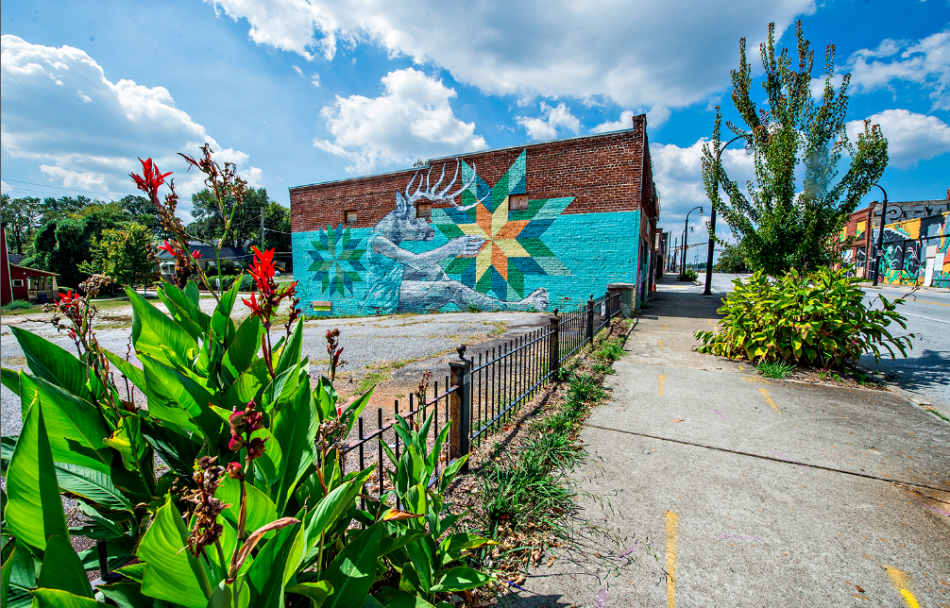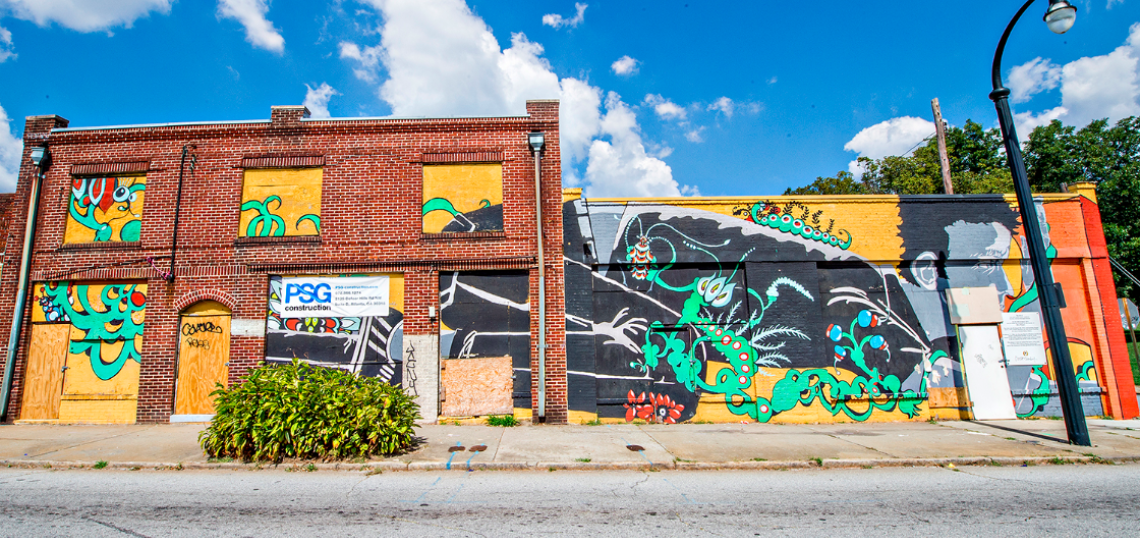One year after the Braves’ final swing at Turner Field, we commissioned photographer Jonathan Phillips to spend an afternoon touring a lifeless collection of architectural eyesores where a once-thriving Black and Jewish community had been driven out by Atlanta’s so-called progress, a growth spurt that included highway expansion and major league sports.
Anyone relatively new to Atlanta won’t recognize that Georgia Avenue of six years ago.
At the time, Georgia Avenue was riddled with boarded-up windows, collapsed ceilings, shaggy unused lots, and trees sprouting along interior walls. What Phillips’ photo essay captured was a beatdown version of a unique—if not inimitable—commercial corridor, just as developer Carter was getting building permits in order and hinting at barbecue and brewery concepts on the horizon.
Fast forward to 2024, and Carter’s redevelopment—titled simply Summerhill—has transformed a significant portion of its 80-acre holdings around the former MLB stadium (now home to Georgia State University football), adding hundreds of apartments, townhomes, houses, a standalone Publix, and 20 new businesses along Georgia Avenue alone.
As illustrated below, the old Georgia Avenue paints a stark, bleaker contrast to today. Call it Atlanta preservation at its finest, a shining example of adaptive-reuse development, or gentrification run amok, but you can’t deny the changes have breathed life and vitality into a moribund section of town that’d left so many Braves fans scratching their heads for a generation.
 The long-empty storefronts of, from left, Halfway Crooks brewery, Big Softie ice cream, and Little Tart Bakeshop in October 2017. Courtesy of Jonathan Phillips Photography
The long-empty storefronts of, from left, Halfway Crooks brewery, Big Softie ice cream, and Little Tart Bakeshop in October 2017. Courtesy of Jonathan Phillips Photography
 Shuttered storefronts where Georgia Avenue meets Reed Street, looking south six years ago. Courtesy of Jonathan Phillips Photography
Shuttered storefronts where Georgia Avenue meets Reed Street, looking south six years ago. Courtesy of Jonathan Phillips Photography
 The buildout of Halfway Crooks' vintage-cool interiors was among the first signs of adaptive-reuse life on Georgia Avenue. Courtesy of Jonathan Phillips Photography
The buildout of Halfway Crooks' vintage-cool interiors was among the first signs of adaptive-reuse life on Georgia Avenue. Courtesy of Jonathan Phillips Photography
 The poetry-bedecked corner building that became Wood's Chapel BBQ. Courtesy of Jonathan Phillips Photography
The poetry-bedecked corner building that became Wood's Chapel BBQ. Courtesy of Jonathan Phillips Photography
 The vast expanses of eastern Turner Field parking lots before the advent of Publix and adjacent ground-up development. Courtesy of Jonathan Phillips Photography
The vast expanses of eastern Turner Field parking lots before the advent of Publix and adjacent ground-up development. Courtesy of Jonathan Phillips Photography
 The ailing structure that would become Hot Dog Pete's at 25 Georgia Ave. Courtesy of Jonathan Phillips Photography
The ailing structure that would become Hot Dog Pete's at 25 Georgia Ave. Courtesy of Jonathan Phillips Photography
 This empty lot (next to today's D Boca N Boca restaurant) would see a contemporary-style new building constructed where Maggie Murphy's hair salon and Hero doughnuts operates. Courtesy of Jonathan Phillips Photography
This empty lot (next to today's D Boca N Boca restaurant) would see a contemporary-style new building constructed where Maggie Murphy's hair salon and Hero doughnuts operates. Courtesy of Jonathan Phillips Photography
 Where new construction was inserted, at center, between two previously vacant structures. Google Maps
Where new construction was inserted, at center, between two previously vacant structures. Google Maps
 Interiors of 39 Georgia Ave., where D Boca N Boca set up shop. Courtesy of Jonathan Phillips Photography
Interiors of 39 Georgia Ave., where D Boca N Boca set up shop. Courtesy of Jonathan Phillips Photography
 The 59 Georgia Ave. structure that became Iconic Orthodontics. Courtesy of Jonathan Phillips Photography
The 59 Georgia Ave. structure that became Iconic Orthodontics. Courtesy of Jonathan Phillips Photography
 The corner building where How Crispy (at left) and celebrated local restaurant Little Bear dish fare today. Courtesy of Jonathan Phillips Photography
The corner building where How Crispy (at left) and celebrated local restaurant Little Bear dish fare today. Courtesy of Jonathan Phillips Photography
 Little Bear's space with a tree that had busted through the back wall. Courtesy of Jonathan Phillips Photography
Little Bear's space with a tree that had busted through the back wall. Courtesy of Jonathan Phillips Photography
 The former parking lot between 71 and 85 Georgia Ave. that came to life as patios for restaurants including Wood's Chapel and Junior's Pizza. Courtesy of Jonathan Phillips Photography
The former parking lot between 71 and 85 Georgia Ave. that came to life as patios for restaurants including Wood's Chapel and Junior's Pizza. Courtesy of Jonathan Phillips Photography
...
Follow us on social media:
Twitter / Facebook/and now: Instagram
• Summerhill news, discussion (Urbanize Atlanta)












